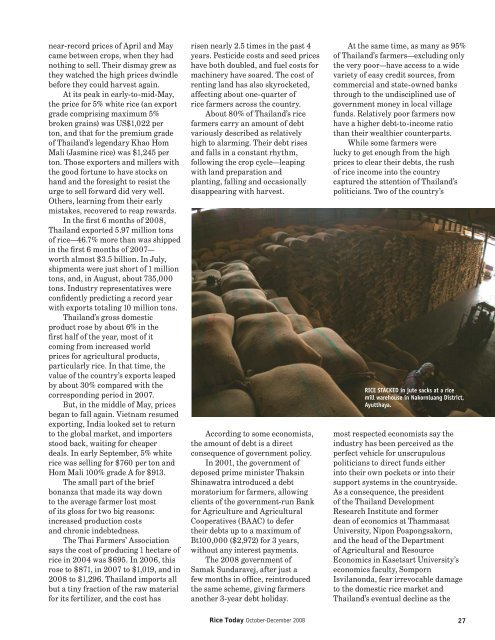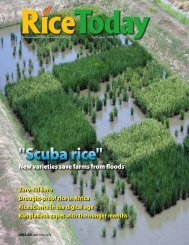Rice Today - adron.sr
Rice Today - adron.sr
Rice Today - adron.sr
You also want an ePaper? Increase the reach of your titles
YUMPU automatically turns print PDFs into web optimized ePapers that Google loves.
near-record prices of April and Maycame between crops, when they hadnothing to sell. Their dismay grew asthey watched the high prices dwindlebefore they could harvest again.At its peak in early-to-mid-May,the price for 5% white rice (an exportgrade comprising maximum 5%broken grains) was US$1,022 perton, and that for the premium gradeof Thailand’s legendary Khao HomMali (Jasmine rice) was $1,245 perton. Those exporters and millers withthe good fortune to have stocks onhand and the foresight to resist theurge to sell forward did very well.Others, learning from their earlymistakes, recovered to reap rewards.In the first 6 months of 2008,Thailand exported 5.97 million tonsof rice—46.7% more than was shippedin the first 6 months of 2007—worth almost $3.5 billion. In July,shipments were just short of 1 milliontons, and, in August, about 735,000tons. Industry representatives wereconfidently predicting a record yearwith exports totaling 10 million tons.Thailand’s gross domesticproduct rose by about 6% in thefirst half of the year, most of itcoming from increased worldprices for agricultural products,particularly rice. In that time, thevalue of the country’s exports leapedby about 30% compared with thecorresponding period in 2007.But, in the middle of May, pricesbegan to fall again. Vietnam resumedexporting, India looked set to returnto the global market, and importersstood back, waiting for cheaperdeals. In early September, 5% whiterice was selling for $760 per ton andHom Mali 100% grade A for $913.The small part of the briefbonanza that made its way downto the average farmer lost mostof its gloss for two big reasons:increased production costsand chronic indebtedness.The Thai Farmers’ Associationsays the cost of producing 1 hectare ofrice in 2004 was $695. In 2006, thi<strong>sr</strong>ose to $871, in 2007 to $1,019, and in2008 to $1,296. Thailand imports allbut a tiny fraction of the raw materialfor its fertilizer, and the cost ha<strong>sr</strong>isen nearly 2.5 times in the past 4years. Pesticide costs and seed priceshave both doubled, and fuel costs formachinery have soared. The cost ofrenting land has also skyrocketed,affecting about one-quarter ofrice farmers across the country.About 80% of Thailand’s ricefarmers carry an amount of debtvariously described as relativelyhigh to alarming. Their debt risesand falls in a constant rhythm,following the crop cycle—leapingwith land preparation andplanting, falling and occasionallydisappearing with harvest.According to some economists,the amount of debt is a directconsequence of government policy.In 2001, the government ofdeposed prime minister ThaksinShinawatra introduced a debtmoratorium for farmers, allowingclients of the government-run Bankfor Agriculture and AgriculturalCooperatives (BAAC) to defertheir debts up to a maximum ofBt100,000 ($2,972) for 3 years,without any interest payments.The 2008 government ofSamak Sundaravej, after just afew months in office, reintroducedthe same scheme, giving farmersanother 3-year debt holiday.At the same time, as many as 95%of Thailand’s farmers—excluding onlythe very poor—have access to a widevariety of easy credit sources, fromcommercial and state-owned banksthrough to the undisciplined use ofgovernment money in local villagefunds. Relatively poor farmers nowhave a higher debt-to-income ratiothan their wealthier counterparts.While some farmers werelucky to get enough from the highprices to clear their debts, the rushof rice income into the countrycaptured the attention of Thailand’spoliticians. Two of the country’sRICE STACKED in jute sacks at a ricemill warehouse in Nakornluang District,Ayutthaya.most respected economists say theindustry has been perceived as theperfect vehicle for unscrupulouspoliticians to direct funds eitherinto their own pockets or into theirsupport systems in the countryside.As a consequence, the presidentof the Thailand DevelopmentResearch Institute and formerdean of economics at ThammasatUniversity, Nipon Poapongsakorn,and the head of the Departmentof Agricultural and ResourceEconomics in Kasetsart University’seconomics faculty, SompornIsvilanonda, fear irrevocable damageto the domestic rice market andThailand’s eventual decline as the<strong>Rice</strong> <strong>Today</strong> October-December 200827RT7-4 (p24-44)_FA.indd 2710/9/2008 8:27:39 AM
















